
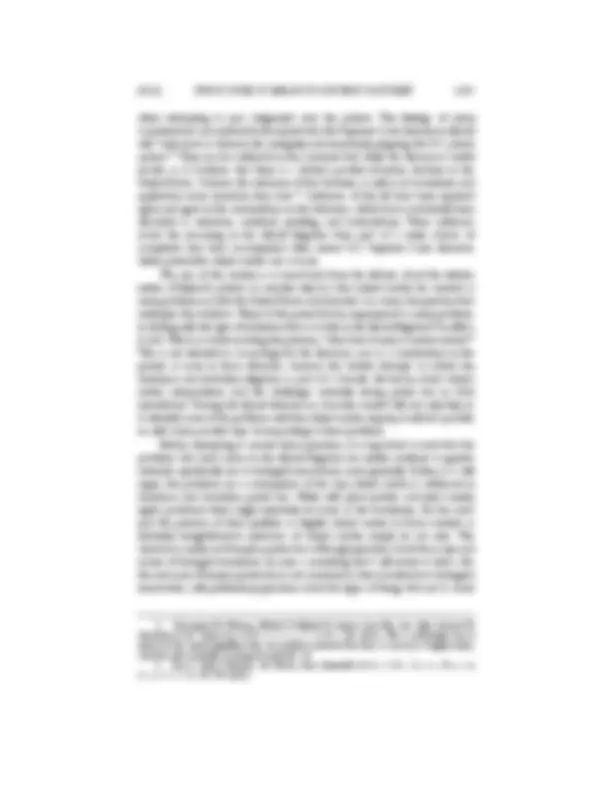
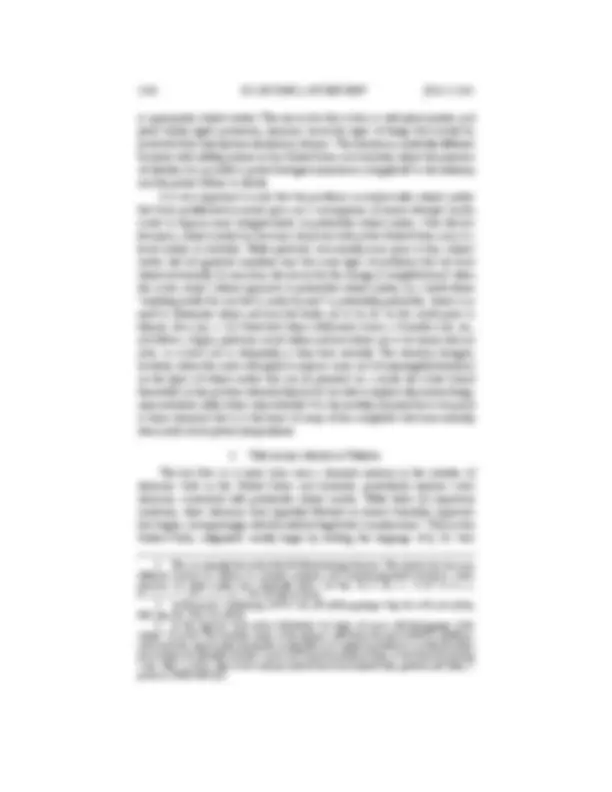
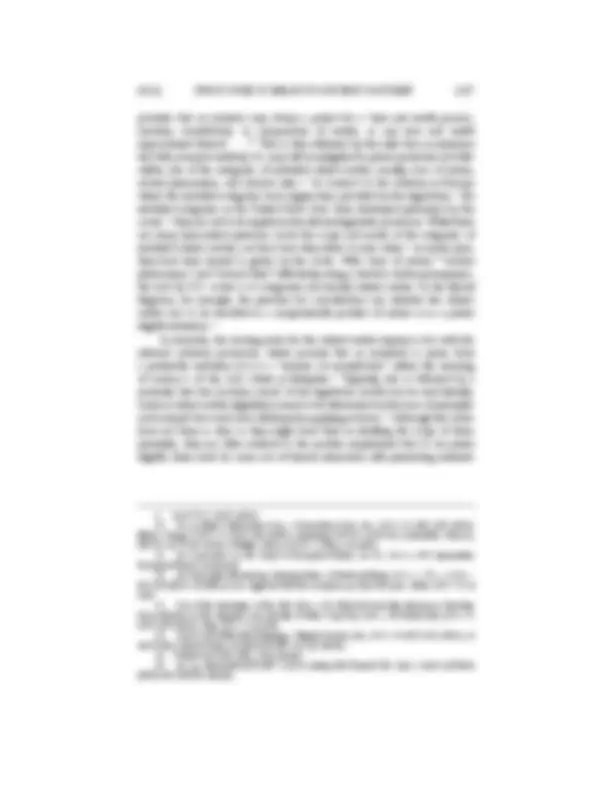
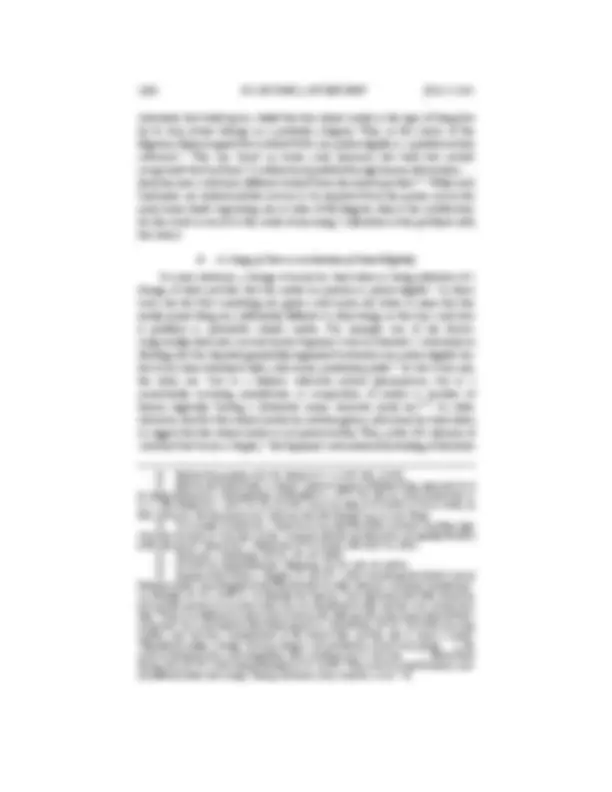
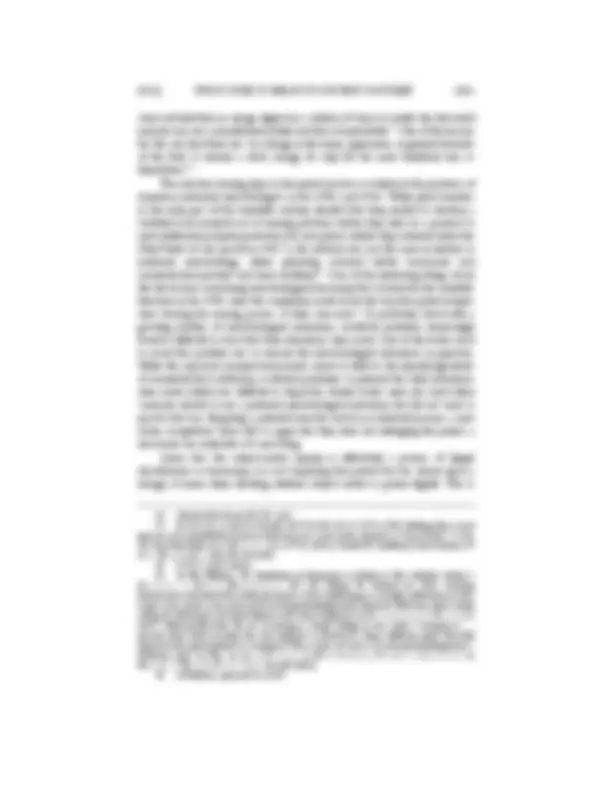
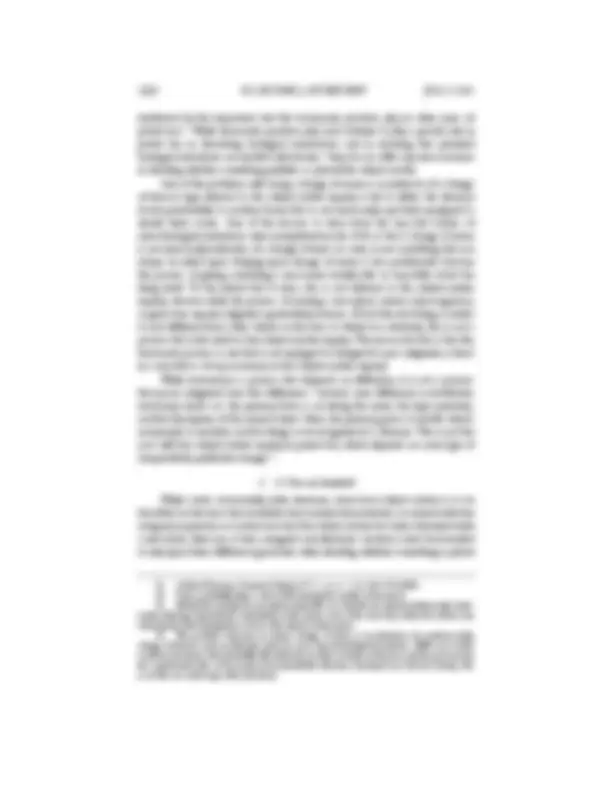
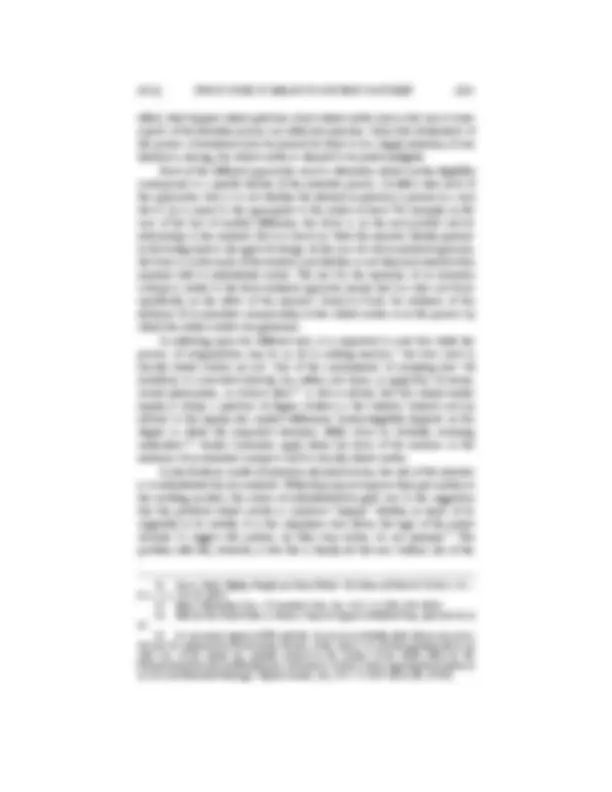
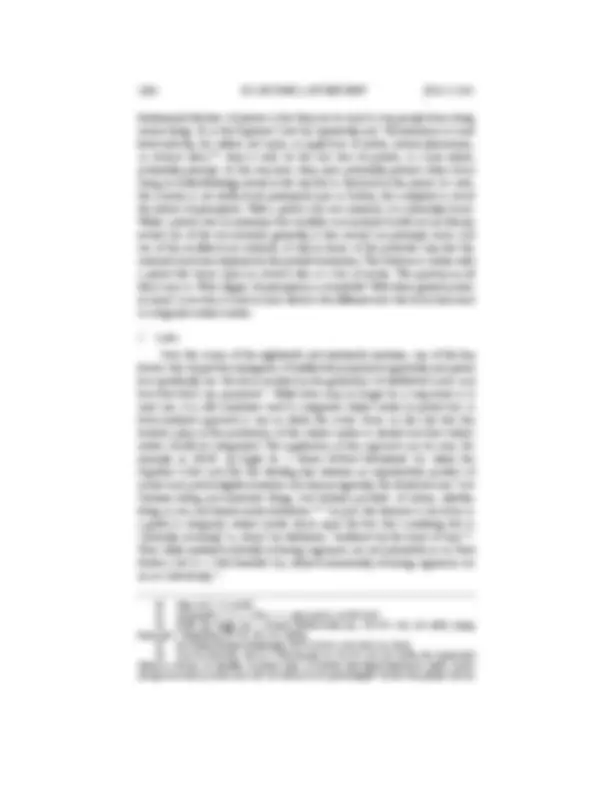
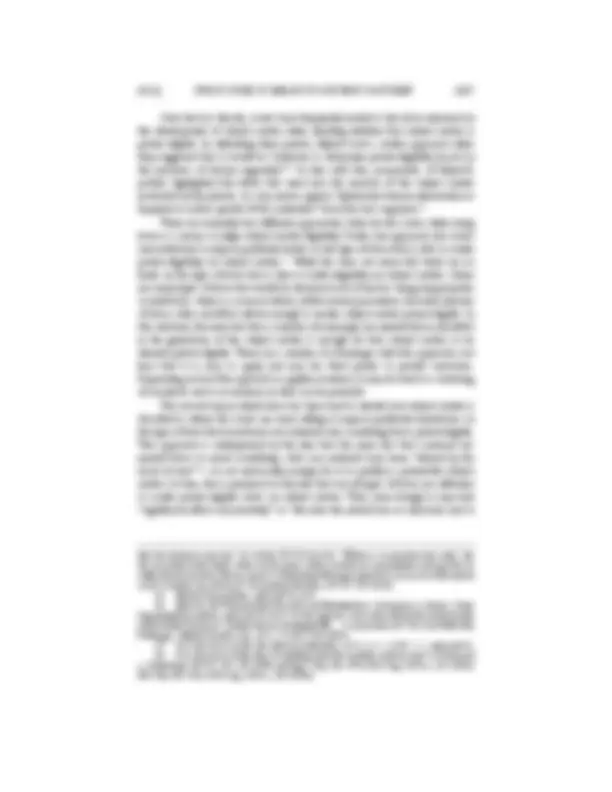
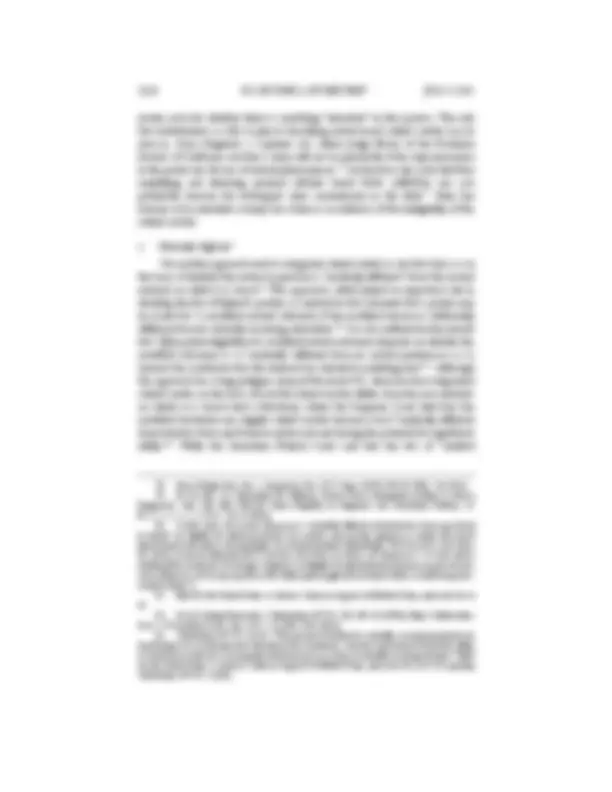
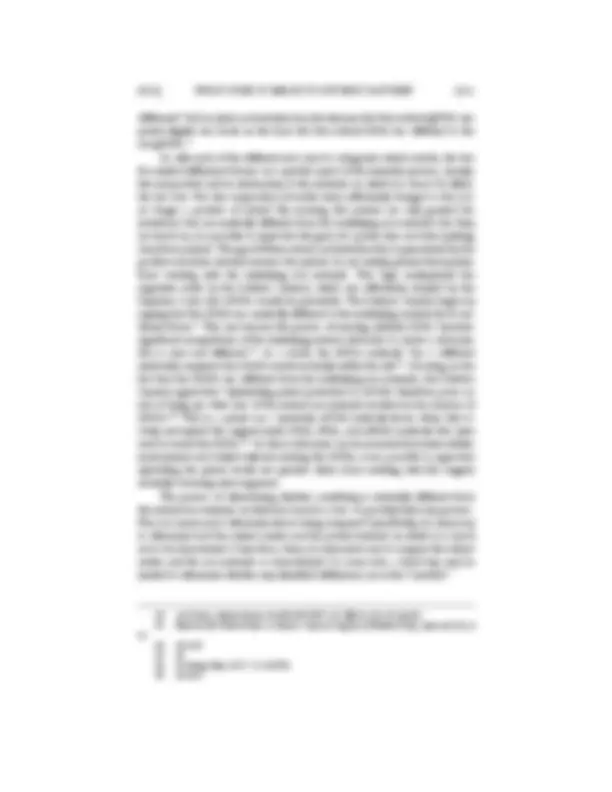
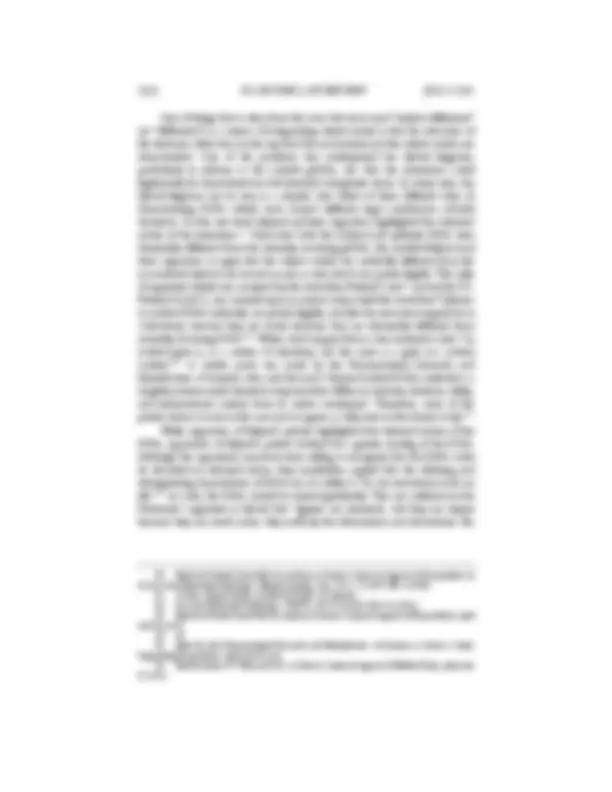
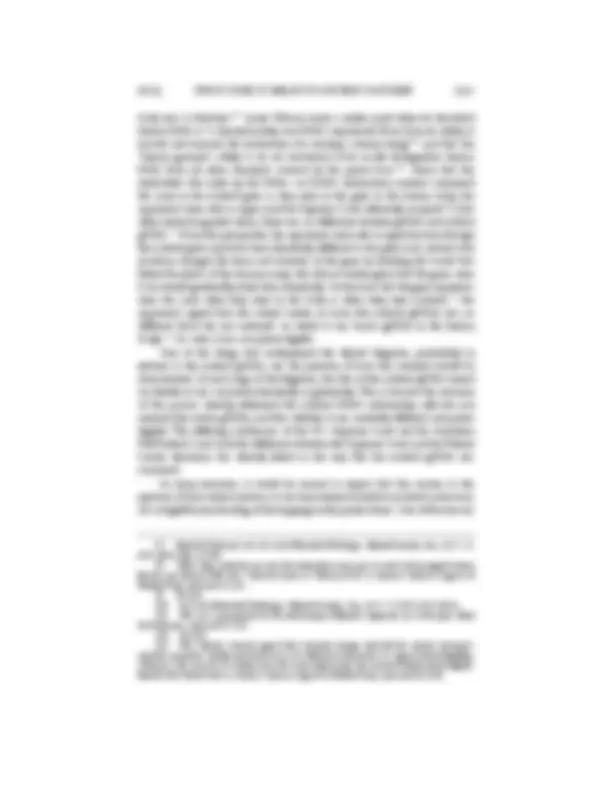
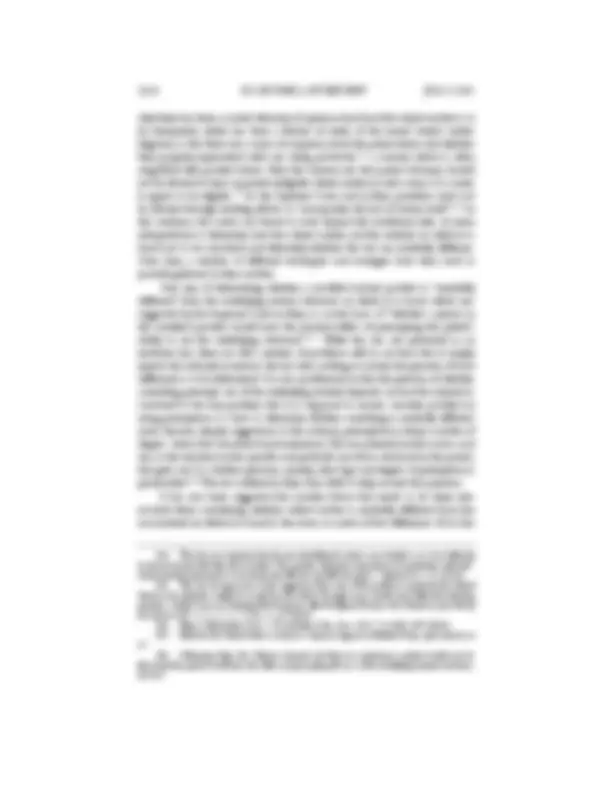

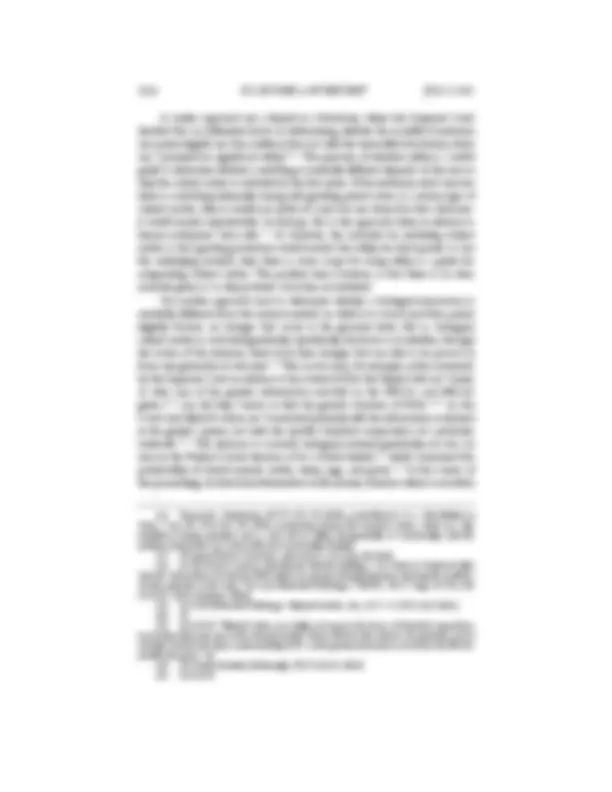
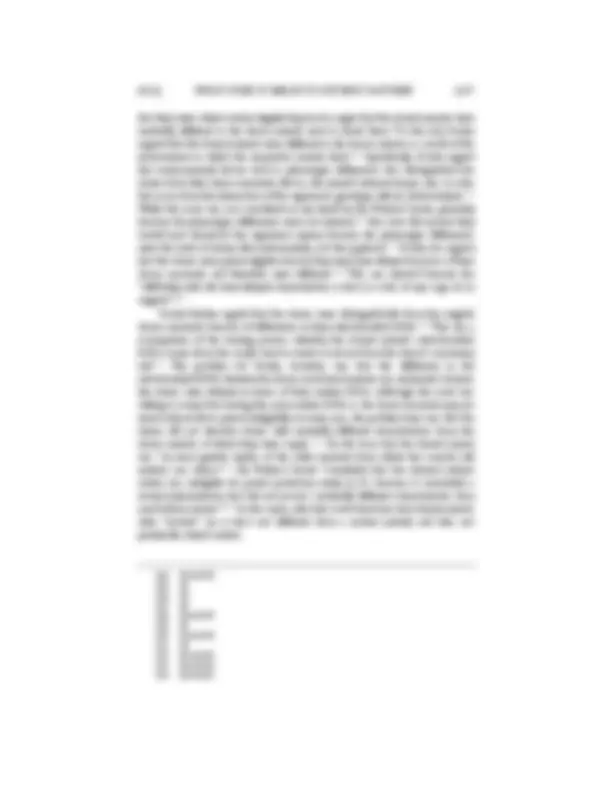
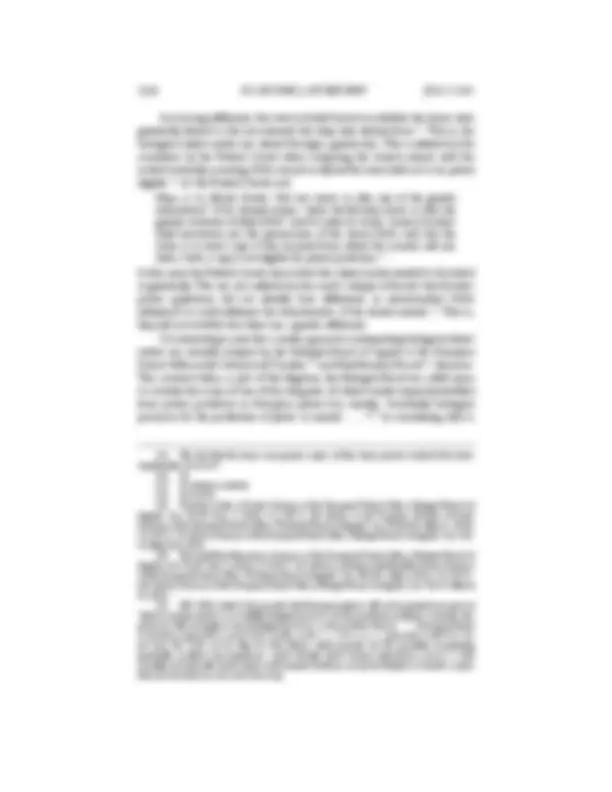
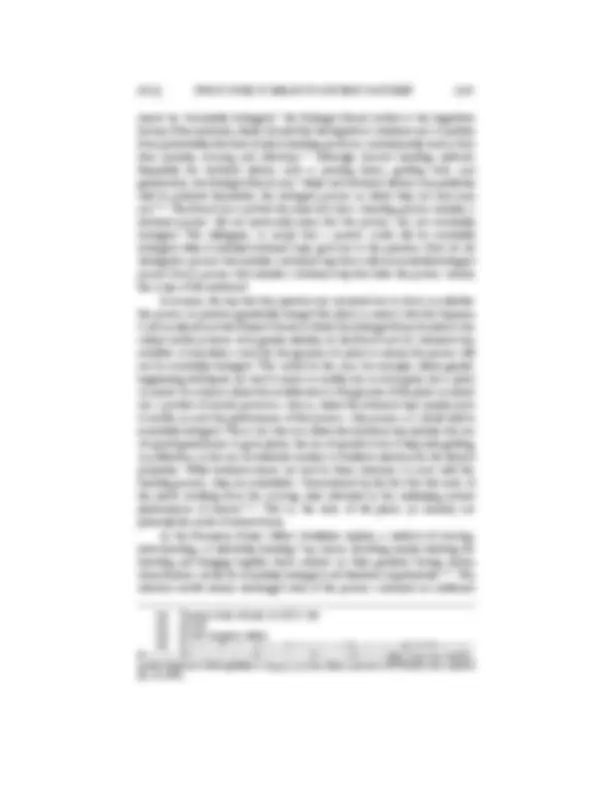
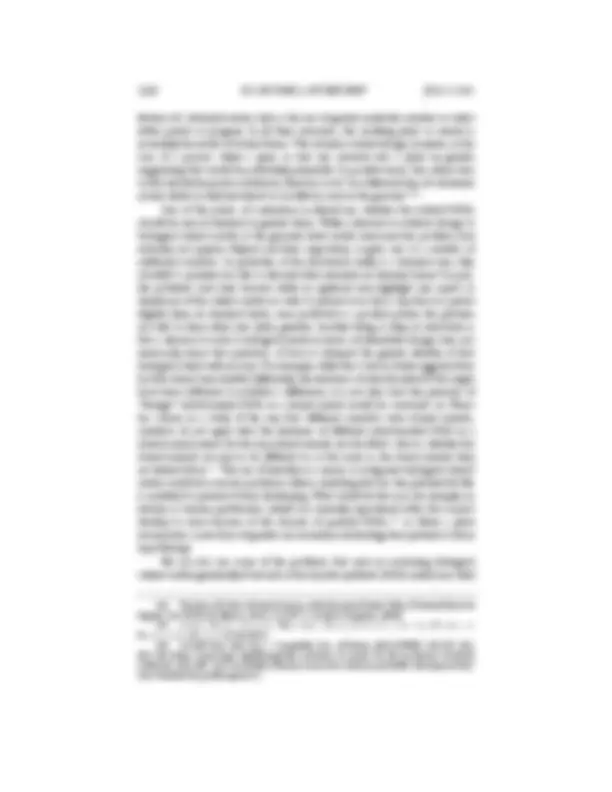
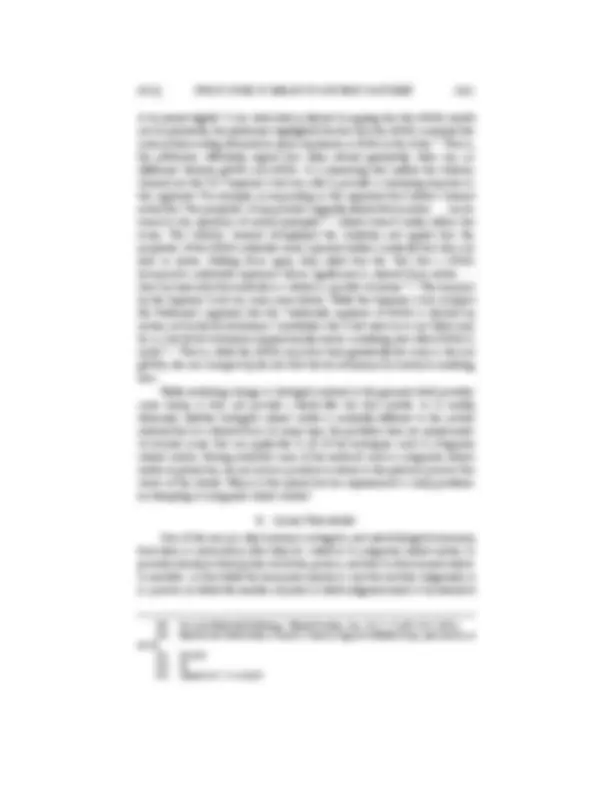
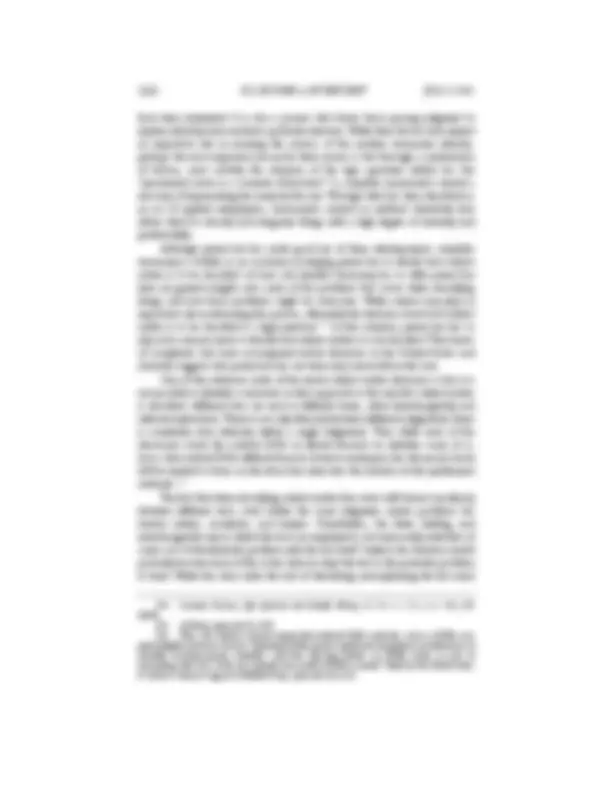
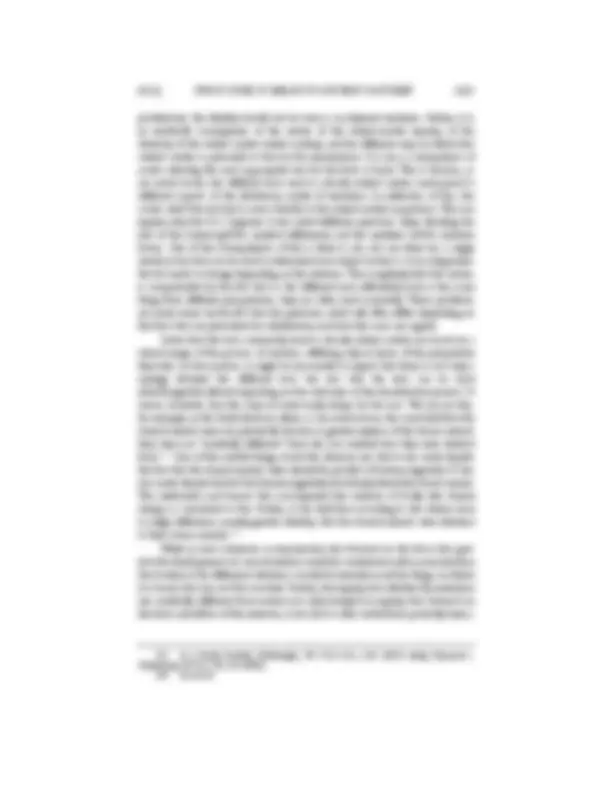
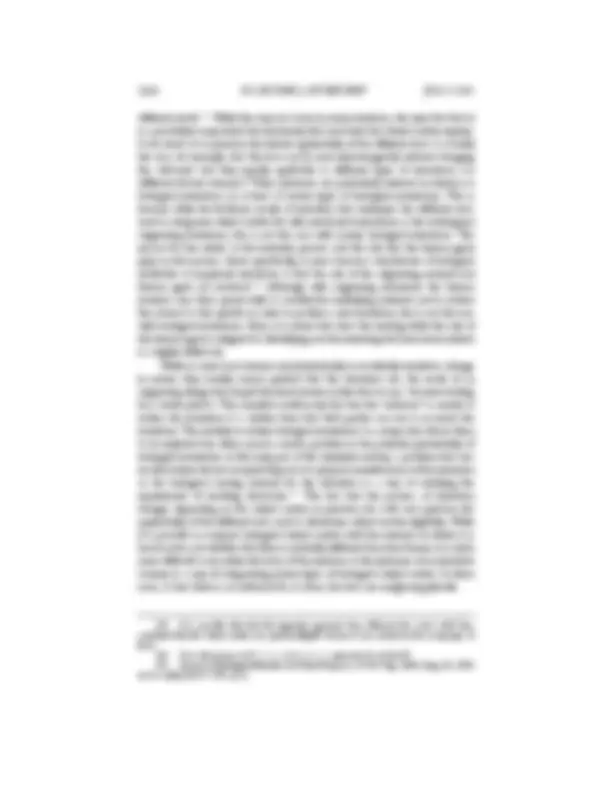

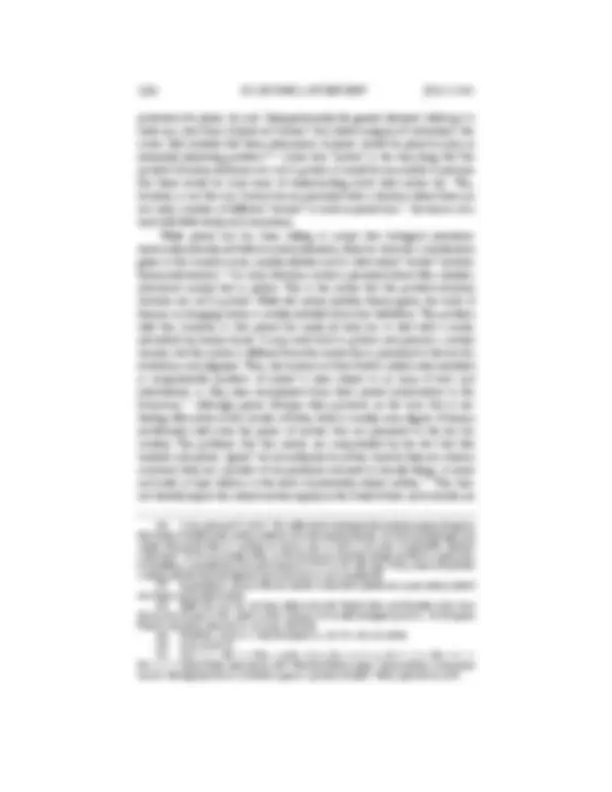
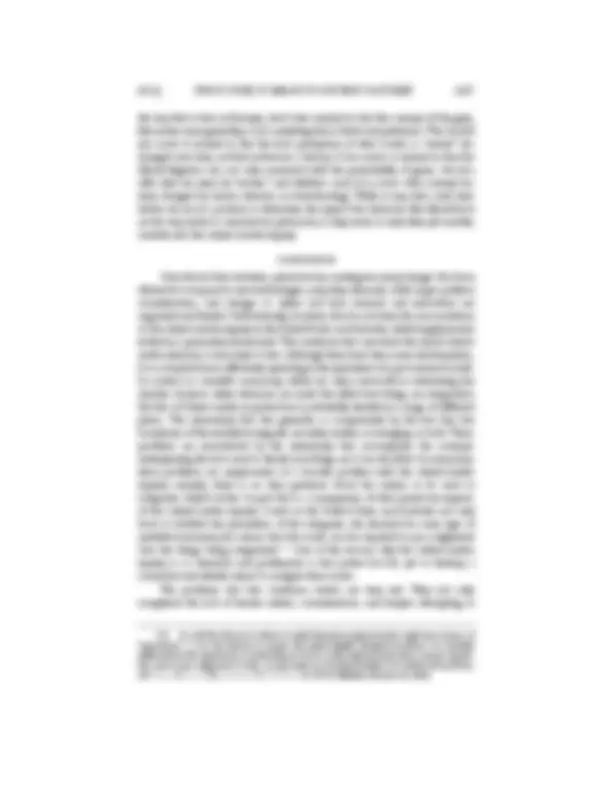
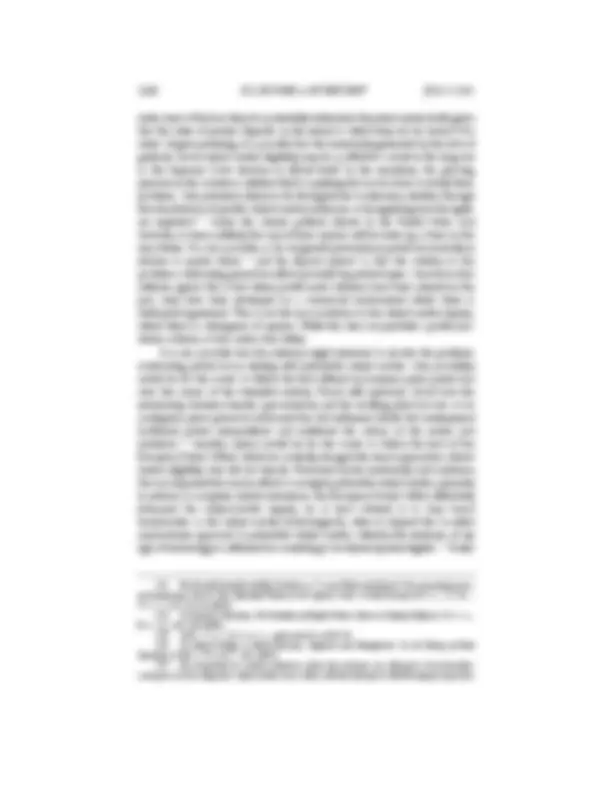
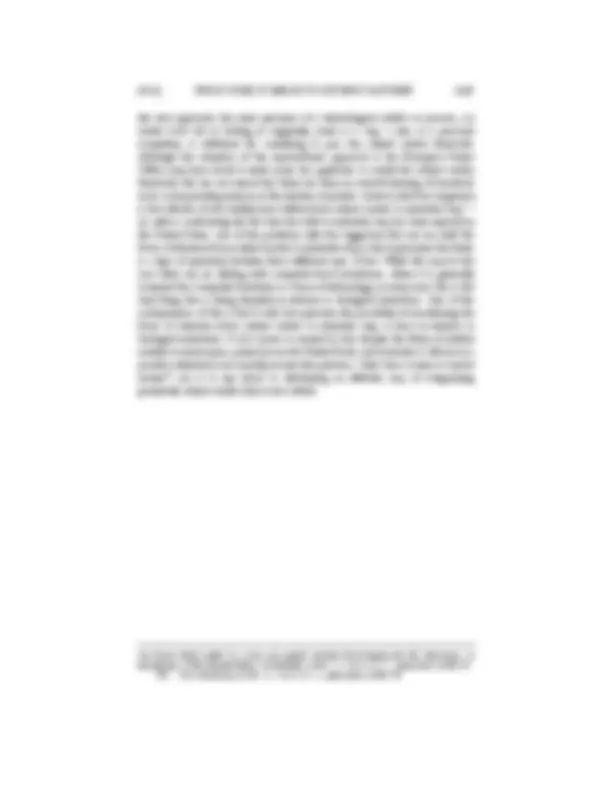



Study with the several resources on Docsity

Earn points by helping other students or get them with a premium plan


Prepare for your exams
Study with the several resources on Docsity

Earn points to download
Earn points by helping other students or get them with a premium plan
Community
Ask the community for help and clear up your study doubts
Discover the best universities in your country according to Docsity users
Free resources
Download our free guides on studying techniques, anxiety management strategies, and thesis advice from Docsity tutors
This article discusses the challenges and uncertainties surrounding subject matter eligibility in patent law, focusing on recent litigation involving Myriad Genetics’ patents for BRCA1 and BRCA2 genes in the US and Australia. The author argues that the lack of clarity in the criteria for categorizing subject matter contributes to the problems, and that patent law in both countries is ill-equipped to determine subject matter eligibility in a non-arbitrary manner. The article also explores the historical context of labor and its role in patent law, and the different approaches to classifying subject matter.
What you will learn
Typology: Study notes
1 / 38

This page cannot be seen from the preview
Don't miss anything!































Introduction ................................................................................................................... 1194 I. The Legal Order of Things ...................................................................................... 1196 A. Natural Kinds........................................................................................... B. A Change of Name as an Indication of Patent Eligibility ................ C. Is There an Invention? ...........................................................................
1194 UC IRVINE LAW REVIEW [Vol. 5:
Over the last few years, there has been a lot written about Myriad Genetics’ controversial patents that grew out of the discovery of the human BRCA1 and BRCA2 genes and the fact that there was a close relationship between mutations in those genes and the development of breast and ovarian cancer. Given the subject matter of these patents 1 and the way that they were implemented, it is not surprising that the patents were met with considerable resistance. It was also not surprising that the patents were challenged in a number of courts around the world. In this Article I wish to focus on two legs of that global litigation—namely, the decisions in the United States that culminated in the 2013 U.S. Supreme Court decision of Association for Molecular Pathology v. Myriad Genetics, Inc.^2 and the ongoing litigation in Australia: the latest instalment being the unanimous 2014 decision by the Full Federal Court in D’Arcy v. Myriad Genetics, Inc.^3 While the secondary literature devoted to Myriad’s patents covers a range of topics from a variety of different perspectives, it is united by the fact that most of the commentary has been very partisan in nature: it has either been written in support of, or against, Myriad’s patents and/or the relevant decision pronouncing on the fate of those patents. While there are some notable exceptions, most of the literature reads as if it was written as either an amicus curiae brief or a policy submission to some fictitious inquiry. On the one side, supporters of the patents have highlighted the important role that patents play in stimulating investment, while downplaying the negative consequences of such protection. In commenting on the U.S. Supreme Court decision, supporters of the patents also raised concerns about the chilling impact the decision might have on research in molecular diagnostics and in cognizant fields of study. On the other hand, critics of the patents have been united in their concern about the negative impact of the patents, particularly upon women’s health. As with many other biological innovations, there is also a sensitivity about the commodification of nature, which is exacerbated by the gravity of the illness, the business model used to exploit the invention, and the way this was perceived outside of the United States as a Trojan horse that was being used to undermine national approaches to health care. While the relative merit of Myriad’s patents is an important issue, in this Article I wish to change tact to focus on a separate issue which has linked both sides of the debate, namely, the criticisms that have been made about the reasoning of the courts
1196 UC IRVINE LAW REVIEW [Vol. 5:
as appropriate subject matter. The reason for this is that, as with plant patents and plant variety rights protection, decisions about the types of things that should be protected have already been decided in advance.^6 The situation is markedly different however with (utility) patents in the United States and Australia where the question of whether it is possible to patent biological inventions is largely left to the judiciary and the patent offices to decide. It is also important to note that the problems associated with subject matter that have proliferated in recent years are a consequence of recent attempts by the courts to impose more stringent limits on patentable subject matter. Over the last few years, subject matter has become a key issue both in the United States and, to a lesser extent, in Australia. While questions occasionally arose prior to this, subject matter did not generate anywhere near the same types of problems that we have witnessed recently. In one sense, the reason for this change is straightforward: when the courts adopt a liberal approach to patentable subject matter, in a world where “anything under the sun that is made by man” is potentially patentable, 7 there is no need to determine where and how the limits are to be set. In the world prior to Myriad , Alice Corp. v. CLS Bank Int’l , Mayo Collaborative Services v. Promethus Labs, Inc. , and Bilski v. Kappos , questions about where and how limits are to be drawn did not arise, or at least not as frequently as they have recently. The situation changed, however, when the courts attempted to impose some sort of (meaningful) limitation on the types of subject matter that can be patented. As a result, the courts found themselves in the position whereby they had to be able to explain why certain things were excluded, while others were included. It is the inability of patent law to respond to these demands that is at the heart of many of the complaints that have recently been made about patent jurisprudence.
I. T HE LEGAL ORDER OF T HINGS The last five or so years have seen a dramatic increase in the number of decisions both in the United States and Australia, particularly superior court decisions, concerned with patentable subject matter. While there are important variations, these decisions have typically followed an almost formulaic approach that begins, unsurprisingly, with the relevant legislative considerations.^8 Thus in the United States, judgments usually begin by reciting the language of § 101 that
provides that an inventor may obtain a patent for a “new and useful process, machine, manufacture, or composition of matter, or any new and useful improvement thereof... .” 9 This is then followed by the rider that an invention that falls prima facie within § 101 may still be ineligible for patent protection if it falls within one of the categories of excluded subject matter, namely, laws of nature, natural phenomena, and abstract ideas. 10 In contrast to the situation in Europe where the excluded categories have largely been provided by the legislature,^11 the excluded categories in the United States have been developed piecemeal by the courts:^12 they are said to be implicit in the relevant legislative provisions. While there are many unanswered questions about the scope and nature of the categories of excluded subject matter, not least how they relate to each other, 13 in recent years they have been treated as givens by the courts. With “laws of nature,” “natural phenomena,” and “abstract ideas” effectively acting as de facto statutory exceptions, the task for U.S. courts is to categorize and classify subject matter. In the Myriad litigation, for example, the question for consideration was whether the subject matter was to be classified as a nonpatentable product of nature or as a patent eligible invention. 14 In Australia, the starting point for the subject-matter inquiry is also with the relevant statutory provisions, which provide that an invention is prima facie a patentable invention if it is a “manner of manufacture” within the meaning of section 6 of the 1623 Statute of Monopolies. 15 Typically, this is followed by a reminder that the Jacobean words of the legislation should not be read literally. Instead, subject matter eligibility is meant to be determined on the basis of principles and concepts the courts have developed in applying section 6.^16 Although the courts have not been as clear as they might have been in distilling the scope of these principles, they are often reduced to the positive requirement that to be patent eligible, there must be some sort of human interaction with preexisting materials
9_. See_ 35 U.S.C. § 101 (2012). 10_. See, e.g._ , Mayo Collaborative Servs. v. Prometheus Labs., Inc., 132 S. Ct. 1289, 1293 (2012); Bilski v. Kappos, 130 S. Ct. 3218, 3225 (2010); Chakrabarty , 447 U.S. at 307–10; Gottschalk v. Benson, 409 U.S. 63, 67–68 (1972); O’Reilly v. Morse, 56 U.S. (1 How.) 62 (1853). 11_. See_ Convention on the Grant of European Patents, art. 53, Oct. 5, 1973 [hereinafter European Patent Convention]. 12_. See_ Christopher Beauchamp, Patenting Nature: A Problem of History , 16 S TAN. TECH. L. R EV. 257, 264 (2013). In Bilski , it was suggested that the exceptions go back 150 years. Bilski , 130 S. Ct. at
One of the advantages of the Alice Corp. v. CLS Bank Int’l and Mayo decisions is that they focus attention on the categories more directly. See Alice Corp. Pty., Ltd. v. CLS Bank, Int’l, 134 S. Ct. 2347, 2354 (2014); Mayo , 132 S. Ct. at 1293. 14_. See_ Ass’n for Molecular Pathology v. Myriad Genetics, Inc., 133 S. Ct. 2107, 2111 (2013); see also D’Arcy v Myriad Genetics, Inc [2014] FCAFC 115, ¶ 1 (Austl.).
Patents Act 1990 (Cth) s 18(1) (Austl.). 16_. See, e.g._ , Myriad [2014] FCAFC 3, ¶ 113 (citing Nat’l Research Dev. Corp. v Comm’r of Patents [1959] 102 CLR 252 (Austl.)).
characteristics or traits that warrant or demand that it be classified in a particular way. In product-of-nature cases, the idea that some things are by their “nature” of a particular type or kind has occasionally been used to categorize things as ineligible products of nature. It has not, however, been used so much to classify things as patent eligible. In many cases, a decision that something is of the type or kind that warrants (or demands) it be classified as an unpatentable product of nature is not contentious. Thus, it has been readily and widely accepted that the discovery of a new mineral or a new plant found in the wild, or a human kidney removed from the body, would be products of nature and as such should be “free to all men and reserved exclusively to none.” 23 In the context of the Myriad litigation, the idea that subject matter could be classified according to its essential traits was used to categorize human genes in situ. This was reflected in the fact that it was widely accepted that genomic DNA—“as a portion of a larger native strand within a cell, which in turn is located within the human body”^24 —was a product of nature and, as such, was not eligible for patent protection. 25 The Solicitor General captured the views of many when he said that in their preisolated form—“as a portion of a larger native gene within a cell—the BRCA sequences clearly are products of nature.”^26 In the Myriad litigation, the idea that certain things were in essence products of nature was, with the exception of the raw gDNA, very contentious. While critics of the patents argued that human genes were “quintessential products of nature,” 27 supporters of the patents took an opposing view and argued that they were “true inventions.” 28 Although the U.S. Supreme Court and the Australian Federal Court, like many of the lower courts, accepted that raw gDNA in the human body was by its very nature the kind of thing that ought to be classified as a nonpatentable product of nature,^29 beyond this the courts did not use essentialist arguments to reach any substantive conclusions. There are a number of problems with such essentialist arguments: one of the most important is that there is rarely if ever any explanation given as to why subject matter is classified in the way that it is. Instead, we are simply presented with bald
1200 UC IRVINE LAW REVIEW [Vol. 5:
statements that build upon a belief that the subject matter is the type of thing that by its very nature belongs in a particular category. Thus, in the course of the litigation, Myriad argued that isolated DNA was patent eligible as a purified natural substance.^30 This was based on lower court decisions that held that natural compounds that had been “so refined and purified through human intervention... [had] become a substance different ‘in kind’ from the natural product.” 31 While such statements are understandable and are to be expected from the parties and in the amici curiae briefs supporting one or other of the litigants, there is less justification for the courts to resort to this mode of reasoning. I will return to the problems with this below.
B. A Change of Name as an Indication of Patent Eligibility In some situations, a change of name has been taken as being indicative of a change of kind and thus that the matter in question is patent eligible. 32 In these cases, the fact that something was given a new name was taken to mean that the newly named thing was sufficiently different to other things in that class such that it qualified as patentable subject matter. For example one of the factors (supposedly) taken into account by the Supreme Court in Diamond v. Chakrabarty in deciding that the disputed genetically engineered bacterium was patent eligible was that it has been christened with a new name: pseudomonas putida.^33 As the Court said, the claim was “not to a hitherto unknown natural phenomenon, but to a nonnaturally occurring manufacture or composition of matter—a product of human ingenuity ‘having a distinctive name, character [and] use.’”^34 In other situations, the fact that subject matter has not been given a new name has been taken to suggest that the subject matter is not patent worthy. Thus, in the 1931 decision of American Fruit Growers v. Brogdex ,^35 the Supreme Court reversed the finding of the lower
1202 UC IRVINE LAW REVIEW [Vol. 5:
reinforced by the important role that taxonomic practices play in other areas of patent law.^41 While taxonomic practices play and continue to play a pivotal role in patent law in describing biological innovations and in ensuring that patented biological inventions are enabled (disclosed),^42 they do not offer any real assistance in deciding whether something qualifies as patentable subject matter. One of the problems with using a change of name as an indicator of a change of kind or type relevant to the subject-matter inquiry is that it defers the decision about patentability to another forum that is not necessarily any better equipped to decide these issues. One of the lessons to draw from the way that names of microbiological inventions were manipulated in the 1950s is that a change of name is not necessarily indicative of a change of kind. As such, it not something that can always be relied upon. Relying upon change of name is also problematic because the process of giving something a new name usually tells us very little about the thing itself. To the extent that it does, this is not relevant to the subject-matter inquiry, because while the process of naming a new plant, animal, microorganism, or gene does require judgment (particularly in terms of how the new thing is similar to and different from other objects in the class to which it is attached), this is not a process that adds much to the subject-matter inquiry. The reason for this is that the taxonomic process is one that is not equipped or designed to pass judgment, at least in a way that is of any assistance in the subject-matter inquiry. While taxonomy is a process that depends on difference, it is not a process that passes judgment over that difference.^43 Instead, once difference is established, taxonomy moves on: the primary focus is on fixing the name, the type specimen, and the description of the named object. Here, the primary goal is to enable objects and people to circulate, and for things to be recognized at a distance. This is not the case with the subject-matter inquiry in patent law, which depends on some type of (unspecified) qualitative change.^44
C. Is There an Invention? While courts occasionally make decisions about how subject matter is to be classified on the basis that it exhibits the essential characteristics associated with the category in question or on the basis that the subject matter has been christened with a new name, these are, at best, marginal considerations. Instead, courts have tended to rely upon three different approaches when deciding whether something is patent
41_. See_ Brad Sherman, Taxonomic Property , 67 CAMBRIDGE L.J. 560, 574 (2008).
eligible. The first approach used to classify subject matter does so on the basis of the labor used to create the invention. A second approach focuses on whether or not there is an inventive concept somehow associated with the subject matter in question. A third approach used to classify subject matter operates on the basis that a nature-based invention will only be patent eligible if the invention is “markedly different” 45 (or in Australian terms “different” 46 ) from the raw material on which it is based. While there are differences between the three approaches, they are all underpinned by the same question, namely, is there an invention?^47 More specifically, each of the approaches used to determine subject matter eligibility implicitly builds upon an image of how inventions come into being—an image, in effect, of the process of invention. It is important to note that the image of how inventions are generated that is employed in patent law is a legal one. Patent law does not attempt to reproduce laboratory life in a legal setting or to mirror or recreate scientific practice. Instead, the model of invention is one that marries a conception of scientific and technical creation with particular policy ends. In essence, the process of invention that underpins the subject-matter inquiry is relatively straightforward. In the context of nature-based inventions, this is one in which the invention is a product of a process in which a human agent (or inventor) exercises their inventive skills to build on, modify, or adapt preexisting natural materials. In this context the “raw materials” act as the foundation or building blocks for the inventive process. A similar image of the inventive process is used in relation to laws of nature and abstract ideas. As the Supreme Court said in Mayo , “all inventions at some level embody, use, reflect, rest upon, or apply laws of nature, natural phenomena, or abstract ideas.”^48 Given the pivotal role that these raw materials and ideas play in the inventive process—“they are the basic tools of scientific and technological work” 49 —it is not surprising that the courts are constantly vigilant to ensure that they are protected, preserved, and maintained and not subject to patent protection. It is here that the excluded categories come into their own: they operate to protect the a priori domain. In the context of the Myriad litigation, this was reflected in the belief that people should not be restricted in their ability to study, use, or research native gDNA. To allow patents to be granted over the raw materials of the inventive process would, as the Solicitor General said, unduly compromise the public’s ability to study and use nature 50 and in so doing
45_. See_ Ass’n for Molecular Pathology v. USPTO, 702 F. Supp. 2d 181, 222 (S.D.N.Y. 2010). 46_. See D’Arcy v Myriad Genetics Inc_ [2014] FCAFC 115, ¶ 211 (Austl.).
effect, what happens where questions about subject matter arise is that one or more aspects of the inventive process are called into question. Given that all elements of the process of invention must be present for there to be a (legal) invention, if one element is missing, the subject matter is deemed to be patent ineligible. Each of the different approaches used to determine subject matter eligibility corresponds to a specific feature of the inventive process. In effect what each of the approaches does is to ask whether the element in question is present in a way that is (or is meant to be) appropriate to the matter in hand. For example, in the case of the test of marked difference, the focus is on the end product and its relationship to the materials that it is based on. Here the inventor silently operates in the background as the agent of change. In the case of a labor-centered approach, the focus is on the work of the inventor and whether or not they have exercised the requisite skill to individualize nature. The test for the existence of an inventive concept is similar to the labor-centered approach, except that it is does not focus specifically on the effort of the inventor. Instead it looks for evidence of the existence of an inventive concept either in the subject matter or in the process by which the subject matter was generated. In reflecting upon the different tests, it is important to note that while the process of categorization may be an all or nothing exercise,^56 the tests used to classify subject matter are not. One of the consequences of accepting that “all inventions at some level embody, use, reflect, rest upon, or apply laws of nature, natural phenomena, or abstract ideas”^57 is that it ensures that the subject-matter inquiry is always a question of degree. Indeed, as the Solicitor General said (in relation to the inquiry into marked difference) “patent-eligibility depends on the degree to which the purported invention differs from its naturally occurring antecedent.”^58 Similar comments apply where the labor of the inventor or the existence of an inventive concept is used to classify subject matter. In the fictitious model of invention described above, the role of the inventor is to individualize the raw materials. While they may not impose their personality on the resulting product, the notion of individualization gives rise to the suggestion that the patented subject matter is somehow “unique,” whether in terms of its originality or its novelty. It is this uniqueness that allows the logic of the patent doctrine to suggest that patents, by their very nature, do not preempt. 59 The problem with this, however, is that this is clearly not the case. Indeed, one of the
1206 UC IRVINE LAW REVIEW [Vol. 5:
fundamental features of patents is that they can be used to stop people from doing certain things. If, as the Supreme Court has repeatedly said, “all inventions at some level embody, use, reflect, rest upon, or apply laws of nature, natural phenomena, or abstract ideas,”^60 then it must be the case that all patents, to some extent, potentially preempt. At the very least, they must potentially prevent others from using (or individualizing) nature in the way that is disclosed in the patent. As such, the concern is not really about preemption per se. Rather, the complaint is about the extent of preemption. With a patent over raw materials, it is extremely broad. While a patent over an invention that modifies raw material should not (in theory) restrict use of the raw materials generally, it does restrict (or preempt) access and use of the modified raw materials, if only in terms of the particular way that the materials have been deployed in the patented invention. The situation is similar with a patent that draws upon an abstract idea or a law of nature. The question in all these cases is: What degree of preemption is acceptable? With these general points in mind, I now turn to look in more detail at the different tests that have been used to categorize subject matter.
1. Labor
Over the course of the eighteenth and nineteenth centuries, one of the key factors that shaped the emergence of intellectual property law generally and patent law specifically was the labor involved in the generation of intellectual assets and how that labor was perceived. 61 While labor may no longer be as important as it once was, it is still sometimes used to categorize subject matter in patent law. A labor-centered approach is one in which the courts focus on the role that the inventor plays in the production of the subject matter to decide how that subject matter should be categorized. The application of this approach can be seen, for example, in J.E.M. Ag Supply Inc. v. Pioneer Hi-Bred International, Inc. where the Supreme Court said that the dividing line between an unpatentable product of nature and a patent eligible invention was human ingenuity: the distinction was “not ‘between living and inanimate things, but between products of nature, whether living or not, and human-made inventions.’”^62 In part, the decision to use labor as a guide to categorize subject matter draws upon the fact that something that is “naturally occurring” is, almost by definition, “unaltered by the hand of man.”^63 Thus while unaltered naturally occurring organisms are not patentable (as in Funk Brothers Seed Co. v. Kalo Inoculant Co. ), altered nonnaturally occurring organisms are (as in Chakrabarty ).^64
60_. Mayo_ , 132 S. Ct. at 1293. 61_. See generally_ SHERMAN & BENTLY , supra note 53, at 1760–1911.
1208 UC IRVINE LAW REVIEW [Vol. 5:
appreciate its potential utility,”^69 this high level “creation” is not patentable. The situation is the same with the discovery of laws of nature and the development of abstract ideas. In these cases, no amount of skill or labor will allow someone to patent the fundamental raw materials that underpin the inventive process. It is also clear that the mere fact that someone has exerted labor and effort to modify and change raw materials will not necessarily be enough to guarantee that the resulting subject matter is patent worthy. This is because patent law only recognizes certain types of labor, often unhelpfully described as inventive labor, as giving rise to patentable subject matter.^70 This need to exercise a particular type of labor was reflected in the comments of the Solicitor General, which were adopted by the Supreme Court in Myriad , that “[s]ynthesized genetic materials such as cDNA are patent-eligible subject matter because they do not occur in nature but instead are the product of significant human creativity.”^71 It was also reflected in the comment by the Supreme Court in relation to the isolated gDNA that “Myriad did not create anything. To be sure, it found an important and useful gene, but separating that gene from its surrounding genetic material is not an act of invention”^72 : labor, but not the right type of labor. Once the decision was made that only certain types of labor exercised in certain ways is able to render subject matter patent eligible, it was not only necessary for decision makers to be able to distinguish between these different types of labor, they also had to be able to provide justifications for doing so. In this situation it was necessary for them to be able to explain why, for example, that a certain type of labor was deemed “creative” enough to produce something that was potentially patentable, while other labor was not. It may be possible to talk at an abstract level about classes of labor (such as the effort of a laboratory manager who plays an important but noninventive role in the generation of a new technology). Beyond this, however, it is much more difficult to use labor, skill, and effort as a means to categorize subject matter, at least in a way that does not appear to be arbitrary. As I demonstrate below, it is the inability of decision makers to do this that lies at the heart of many of the problems facing patent law in this context. The problems that arise when using labor to categorize subject matter are compounded by the fact that it is not clear what is being judged here. Is it the case, for example, that parties need to produce evidence of the skill and effort actually used to generate the subject matter (as with inventive step)—which seems to run counter to the idea that the
subject-matter inquiry is a preliminary examination—or is it that the case that the decision is made on the basis of the indicative labor used to generate subject matter of the type in question? Given the uncertainty about the type, degree, and amount of labor needed to render subject matter patent worthy, it is not surprising that where labor is used to categorize subject matter that the focus of attention often shifts to the product of that labor. In these instances, the labor of the inventor is treated as a proxy for change, which is reflected in the end product and the fact that is markedly different from the raw materials on which it is based. This can be seen in the now repealed 2001 USPTO Utility Examination Guidelines that stated that isolated and purified naturally occurring DNA was patent eligible. 73 While the shift away from a focus on the labor used to generate subject matter as an end in its own right toward the change that the labor has on the (more concrete) resulting product may have some advantages, it does not really solve the problem of how subject matter is to be classified so much as defer the question to another area of doctrine, which (as we will see below), has its own problems.
2. “Inventive Concept”
Another approach used to classify subject matter is one that does so on the basis of whether the subject matter incorporates an inventive concept. This is premised on the idea that to be patent eligible, subject matter that is based on a law of nature, natural phenomenon, or an abstract idea must include an “inventive concept.” 74 In Alice Corp. —which considered whether a patent for a computer- implemented invention designed to facilitate securities trading was excluded on the basis that it was for an abstract idea—the test for eligibility was presented as a two- stage process.^75 First, it is necessary to identify whether the claim in question was directed to an abstract idea. 76 It is then necessary to examine the claims to determine whether they contain an “inventive concept” sufficient to transform the abstract idea into something that is patent eligible. 77 A similar approach is sometimes used when deciding whether subject matter is excluded on the basis that it embodies natural phenomenon or a law of nature. In one sense, the use of the existence of an inventive concept as a means of categorizing subject matter is similar to the approach outlined above, whereby subject matter is categorized on the basis of the type or quality of labor used to generate the subject matter in question. In other senses, however, it is different. Specifically, while a labor-centered approach focuses on the role that the inventor plays in the production of the subject matter, this approach looks more holistically at the inventive process, at the individualization of
difference” had no place in Australian law, the decision that the isolated gDNA was patent eligible was made on the basis that the isolated DNA was different to the raw gDNA.^84 As with each of the different tests used to categorize subject matter, the test for marked difference focuses on a specific aspect of the inventive process, namely, the end product and its relationship to the materials on which it is based. In effect, the test asks: Has the composition of matter been sufficiently changed so that it is no longer a product of nature? By ensuring that patents are only granted for inventions that are markedly different from the underlying raw materials that they are based on, it is possible to argue that the grant of a patent does not take anything away from anyone. The gap between nature and invention that is guaranteed by the product-of-nature doctrine ensures that patents do not unduly prevent third parties from working with the underlying raw materials. This logic underpinned the argument made by the Solicitor General, which was effectively adopted by the Supreme Court, that cDNA should be patentable. The Solicitor General began by arguing that the cDNA was markedly different to the underlying material that it was derived from.^85 This was because the process of creating synthetic DNA “involves significant manipulation of the underlying natural substances to create a substance that is new and different.”^86 As a result, the cDNA molecule “has a different nucleotide sequence than DNA created naturally within the cell.”^87 Drawing on the fact that the cDNA was different from the underlying raw materials, the Solicitor General argued that “[e]xtending patent protection to cDNAs therefore poses no risk of ‘tying up’ other uses of the natural raw materials involved in the creation of cDNA.”^88 That is, a patent on a “particular cDNA molecule leaves others free to study and exploit the original native DNA, RNA, and mRNA molecule that were used to create the cDNA.”^89 As these substances can be removed from their cellular environment and studied without creating the cDNA, it was possible to argue that upholding the patent would not prevent others from working with the original naturally occurring microorganism. The process of determining whether something is materially different from the natural raw materials on which it is based is a two- or possibly three-step process. First, it is necessary to determine what is being compared. Specifically, it is necessary to determine how the subject matter and the natural material on which it is based are to be characterized. Once this is done, it is then necessary to compare the subject matter and the raw materials as characterized. In some cases, a third step may be needed to determine whether any identified differences are in fact “marked.”
84_. See D’Arcy v Myriad Genetics, Inc_ [2014] FCAFC 115, ¶¶ 114, 213–18 (Austl.).
86_. Id._ at 18. 87_. Id._ 88_. Id._ (citing Mayo , 132 S. Ct. at 1294).
1212 UC IRVINE LAW REVIEW [Vol. 5:
One of things that is clear from the cases that have used “marked difference” (or “difference”) as a means of categorizing subject matter is that the outcomes of the decisions often turn on the way that the raw material and the subject matter are characterized. One of the problems that underpinned the Myriad litigation, particularly in relation to the isolated gDNA, was that the inventions could legitimately be characterized in both chemical and genetic terms. In many ways, the Myriad litigation can be seen as a dispute over which of these different ways of characterizing DNA—which each carried different legal conclusions—should dominate. On the one hand, Myriad and their supporters highlighted the chemical nature of the inventions. 90 Given that both the isolated and synthetic DNA were chemically different from the naturally occurring gDNA, this enabled Myriad and their supporters to argue that the subject matter was markedly different from the raw material which it was based on and, as such, that it was patent eligible. This style of argument (which was accepted by the Australian Federal Court^91 and by the U.S. Federal Circuit^92 ), was summed up in an amicus curiae brief that stated that “[c]laims to isolated DNA molecules are patent-eligible, just like the new microorganisms in Chakrabarty , because they are novel creations that are chemically different from naturally-occurring DNA.” 93 While a leaf snapped from a tree remained a leaf, “an isolated gene is, as a matter of chemistry, not the same as a gene in a natural context.” 94 A similar point was made by the Pharmaceutical Research and Manufactures of America who said that each “claimed isolated DNA molecule is a tangible, human-made chemical compound that differs in structure, function, utility, and informational content from its native counterpart. Therefore, none of the patent claims at issue in this case read on genes as they exist in the human body.”^95 While supporters of Myriad’s patents highlighted the chemical nature of the DNA, opponents of Myriad’s patents lobbied for a genetic reading of the DNA. Although the opponents may have been willing to recognize that the DNA could be described in chemical terms, they nonetheless argued that the defining and distinguishing characteristic of DNA was its ability to “be our instruction book on life.” 96 As such, the DNA should be viewed genetically. This was reflected in the Petitioner’s argument in Myriad that “[g]enes are chemicals, but they are unique because they are much more; they embody the information and instructions the